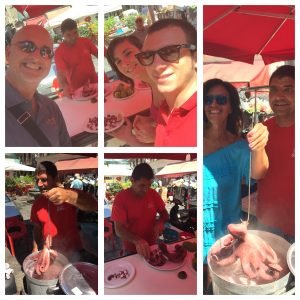Palermo: It’s About the Street Food
Treating yourself to the local street food in Palermo is an event all on its own. But first I was on a mission to find the little chapel located in the historic center of Palermo called Chiesa di Santa Cita. The Oratorio del Rosario di Santa Cita is a small chapel dedicated to the Virgin of the Rosary.
The oratory was built in the 16th century, between 1686 and 1718, and the artist Giacomo Serpotta created the amazing stucco decorations that surround the oratorio. I found the representation of the Mysteries of the Rosary one of the most enchanting works of art in cathedrals and churches I have ever seen. Stucco figures composed of putti, allegorical statues and theaters totally surround you. The theater boxes represent the joyful mysteries, sorrowful mysteries and glorious mysteries and the details of these figures come to life with exquisite detail.
After our visit to the chapel, we headed off for some lunch, hungry to try an assortment of Palermo’s famous street food. Here in Sicily, you can eat at any time, and with your hands. Take it away or eat on the spot, as the Greeks and Romans did in the “thermopolium.” This outdoor mall was an area for meeting, resting and enjoying ready-to-eat foods. In Sicily, take away and fast food have origins on the Island for about 2000 years. Nowadays, “street cuisine” or buffittieri”, from the French word buffet, makes up a significant part of the Sicilian cuisine. One can find it in the ancient markets, along alleys and small squares of the coast cities, Catania, Siracusa or Agrigento. Street cuisine enjoys a great success in Palermo. This is where we had our first stop for some “polpo bollito,” or stewed octopus.
Although it is not so ancient, as far as street food, the octopus has a natural habitat close to the coasts and has been fished since ancient times. However, locals only ate the most tender ones, cooked in a saucepan. On the contrary, those which weighed more than one kilo were thrown away, since the chewy tentacles rendered them almost impossible to eat. The only way to fully cook them required the consumption of precious combustible material. During the Second World War the locals serviced the allied GIs, who had disembarked in Sicily in the summer of 1943. Since the old fishermen couldn’t go too far with their small rowboats, they enlisted help from a boy of Mondello (a local Palermo beach town). They stewed the easily caught larger octopus, and the boy sold some to the men of the allied forces. The GI’s enjoyed the sliced tentacles, and so it was, a real success story.
We found a vendor in a tent who dropped the octopus into a large pot of boiling water. He sliced the rose-colored cooked octopus on a plate and splashed some fresh lemon juice over it. We added a little olive oil and then found a shaded place to consume our first catch of the day.
Then it was off to Antica Focacceria San Francesco, a restaurant that turned an ancient chapel into a “place of worship for the palate,” since 1834. It’s kind of a touristy spot, but sometimes you just have to be a tourist. That said, I recommend just ordering your own food right from the counter and finding a spot to sit in this historic former chapel.
My cousins Alba and Vincenzo picked-out several specialties. I relished my favorite items, the sfincione and arancine. The name sfincione derives from Latin “spongia” (sponge), which is the name of the spongy flour dough. Sfincione is a delicacy placed in a baking pan and put into the oven that shall not be confused with pizza, with which it has nothing in common. It is enhanced with pieces of caciocavallo cheese, typical of Sicily, and covered by salted sardines, tomato sauce, onion, fresh grated caciocavallo and a drop of good-smelling olive oil (to which I added several more). The nuns of the convent of San Vito invented it in the middle of the 17th century.
My next favorite was the arancine, an invention of the Saracens. Although I’ve had this dish many times, I love it so much, it’s a must. Holding an arancina in your hand is like touching more than 1000 years of cuisine.
The stuffed sardines had a deep rich flavor and the the panelle crocche (potato croquettes) and focaccia where perfect accompaniments for our street food luncheon. Now the pane on la milza, was another story.
The name means bread with spleen. That’s right. Spleen! Not the most common meat product for your average American. Now add slices of lung, and pieces of trachea cartilages which is then slightly fried in lard, and you have a recipe that will really wig out most Americans, including me.
Although there were several desserts to choose from at Antica Focacceria San Francesco we decided on some granita, an icy fruit flavored dessert to help cool down on a hot August day. We picked a famous gelateria, Spinnato, which has been in business since 1860. We walked off some of the calories from lunch as well as viewed Sicilian sights along the way. Just before reaching the gelateria we stopped to hear a trio of Sicilian musicians entertaining a large crowd. Now it’s fun to watch a street vendor shave the ice to serve granite on the street, but don’t settle for flavor out of a syrup bottle. At Spinnato, our perfect granita was made with fresh lemon and fresh almonds. Our server had a cheery welcoming smile and the granite was as good as you can get in Palermo. Alba and Vincenzo chose lemon, and I enjoyed an almond granite.
I hope one day my readers can experience this amazing day in Palermo, the place where street food all began.
Blog Posts











